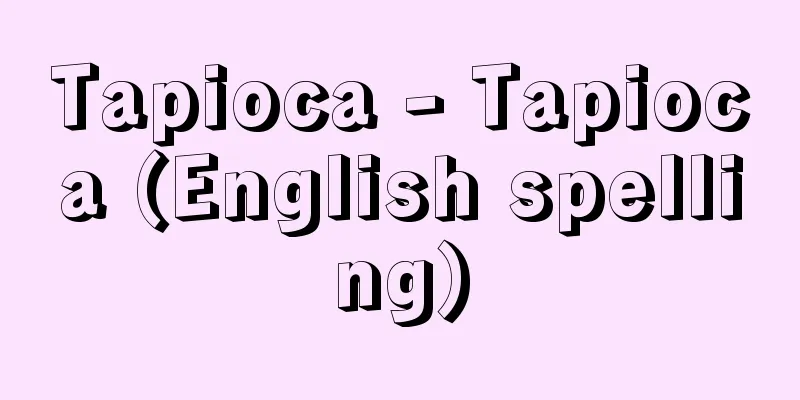Tapioca - Tapioca (English spelling)

|
Starch extracted from cassava roots. Also called cassava starch or manioca starch. Cassava is an important resource, almost a staple food, in tropical regions such as Southeast Asia, Africa, and Brazil. To produce tapioca, the raw material cassava is first washed with water and then crushed in a grinder, and the starch is washed out in water and allowed to settle and collected. This starch is refined by repeating the settling process while changing the water or by using a centrifuge, and then dehydrated and dried. Cassava roots contain the toxic component hydrocyanic acid, but this is removed by soaking in water, heating, drying, etc. In this way, pure white tapioca with few impurities is obtained. There are several types of tapioca processed products. Tapioca pearls are made by forming wet tapioca into spheres 3 to 6 mm in diameter and heating to gelatinize only the surface, and smaller spheres are called tapioca seeds. Tapioca flakes are dried pieces, while tapioca flower is finely ground. When tapioca is boiled, it becomes a transparent paste, which is easy to digest and absorb, so it is used as a breakfast or food for sick people by adding milk and sugar. It is also used in desserts such as tapioca pudding. For industrial purposes, it is used as a thickening agent and adhesive. [Tomomi Kono and Yonago Yamaguchi] [References] |©Shogakukan "> Tapioca pearls Source: Shogakukan Encyclopedia Nipponica About Encyclopedia Nipponica Information | Legend |
|
キャッサバの根塊からとったデンプン。キャッサバデンプン、マニオカデンプンともいう。キャッサバは東南アジア、アフリカ、ブラジルなど熱帯地方では主食に近い重要な資源となっている。タピオカの製造は、まず原料のキャッサバを水洗後、摩砕機ですりつぶし、水中にデンプンを洗い出し、沈殿させて集める。このデンプンを、水をかえながら沈殿を繰り返すか、遠心機にかけるなどして精製し、脱水後乾燥する。キャッサバの根塊には有毒成分の青酸が含まれているが、水浸、加熱、乾燥などにより除去される。このようにして純白で不純物の少ないタピオカが得られる。タピオカにはいくつかの加工品がある。タピオカパールは、湿った状態のタピオカを径3~6ミリメートルの球形につくり、加熱して表面だけを糊化(こか)したもので、さらに小さい球形にしたものはタピオカシードという。タピオカフレークは切片状に乾かしたもの、タピオカフラワーは微細粉にしたものである。タピオカは煮ると透明な糊(のり)状となり、消化吸収もたいへんよいので、牛乳や砂糖などを加え、病人食や朝食として用いられる。タピオカプディングなどデザートにも用いる。工業用としては、糊料、接着剤に利用される。 [河野友美・山口米子] [参照項目] |©Shogakukan"> タピオカパール 出典 小学館 日本大百科全書(ニッポニカ)日本大百科全書(ニッポニカ)について 情報 | 凡例 |
Recommend
Erythroblastosis fetalis
Hemolytic disease of the fetus (also called hemoly...
Gethsemane
…Gethsemane means "Olive Oil Press" in ...
Ribes horridum (English spelling) Ribeshorridum
… [Matsui Jin]. … *Some of the terminology that m...
Ando Nokari - Ando Nukari
A poet and scholar of Japanese classics in the la...
Edinburgh Castle - Edinburgh Castle (English spelling)
Edinburgh is a royal castle in the capital of the...
Lieutenant-Governor
…Official name: CanadaArea: 9,976,100 km2Populati...
Battle of Leningrad - Leningrad Kobosen
One of the fiercest battles for cities during the ...
Warm air heater - Onpuudanbouki
…If you add a chimney like a coal stove, more tha...
Agano Street - Agano Street
...The central city of Chichibu and valley-mouth ...
Limestone cave - shounyuudo
Also known as limestone caves, they are a type of...
Chausa
…In 1764, the British East India Company army led...
Sybs
...In Korea, it is called taepyeongso or kotei, a...
Humidity control
This is the process of adjusting the humidity in ...
Silchester
...The surrounding area is home to the Barafield ...
Amelios
…The people who gathered around Plotinus were mai...









